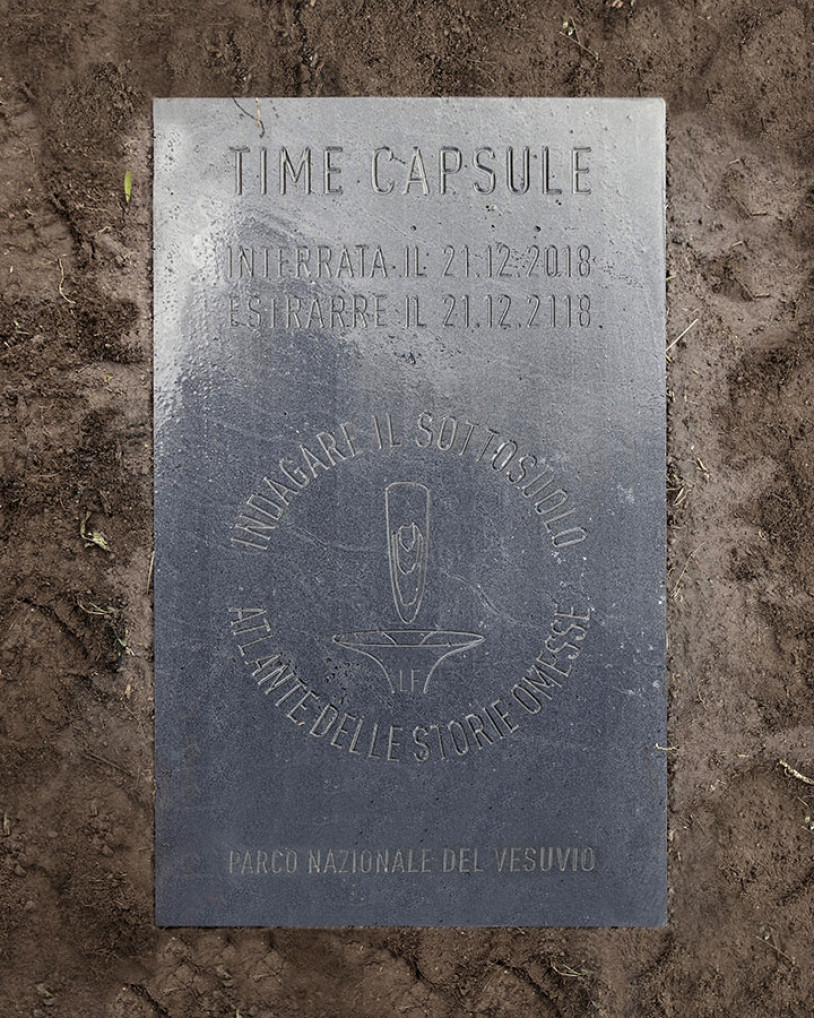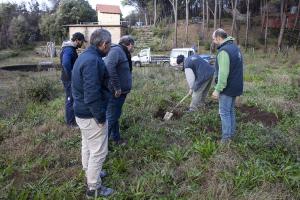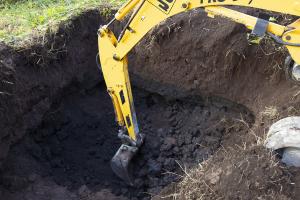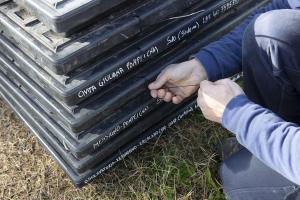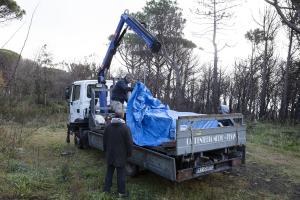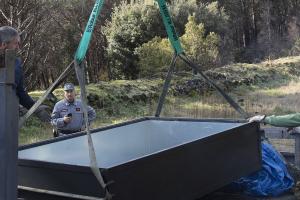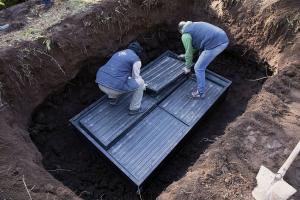
The slope that rises up towards the mouth of Vesuvius is tempered by the Collina del Salvatore, which for the past two centuries has been chosen as the most suitable place for studying the volcano. This is where we find the historic Vesuvius Observatory and where the most sophisticated instruments have recently been installed for the National Institute of Geophysics and Volcanology. In 2018, scientific speculations have been joined by those that conceptually arise from Lara Favaretto’s project Digging up: Atlas of the Blank Histories, which is a sort of present-day update of the eighteenth- and nineteenth-century tastes that made Vesuvius one of the most often depicted naturalistic subjects in the world. Taken together, the scientific and artistic devices allude to a dimension that goes beyond the limits of time and space, in which all the different ages of the volcano, its visible surface and its inner depths come together.
Going up the sides of the mountain, along the curves of a profile that, for centuries, has been etched into memories and the imagination, it is hard even to imagine that what we see now dates back not even a century, to 1944, when the last eruption gave the mountain its current shape. Vesuvius is an imperfect, paradoxical metonymy: it is the image and emblem of the city of Naples, yet its internal structure and perhaps its very identity never cease to change. The volcano is a certain and yet also a changeable, violently shaken symbol. We often see Leopardi’s expanses of gorse, which grow rapidly here even after the worst destruction. As we look down over the gulf and the sea of concrete that stretches from its slopes all the way to the city centre, it is easy to forget that our feet are resting on fiery ground: fertile, but schizophrenic.
The mythology linked to the formation of Vesuvius includes many legends that are based on the idea of living flesh turning into stone and lava: Vesuvius may be a centaur in love with the siren Parthenope or, according to Matilde Serao in her Leggende Napolitane (Neapolitan Legends), a nobleman inveigled by the beautiful Capri, one of the daughters of an enemy family. What all these stories have in common is a thwarted passion, in which the earthquakes are transposed by folklore into the tremors, shocks and endless, violent desperation of unrequited love. And it is said that a unique form of transubstantiation occurred on Vesuvius: the autochthonous vine from which the precious Lacryma Christi wine is produced is said to have been fertilised by the tears of pain shed by Christ when, in the Gulf of Naples, he saw a piece of sky torn off by Lucifer during his fall.
On the road that winds its way up towards the crater, at the height of the Collina del Salvatore, the historic Vesuvius Observatory still appears to visitors with its pale-red nineteenth-century facade, like those of many Neapolitan buildings of that period. When it opened in 1845, this small building was the first scientific institute in the world dedicated to volcanology. It now houses a museum where the first seismographs in history are on display: one was designed by Ascanio di Filomarino della Torre, a Neapolitan follower of the Enlightenment, in 1795 – a year after the eruption that destroyed Torre del Greco. The historian and soldier Pietro Colletta, who was nineteen at the time, stated that “a column of fire advancing upwards was seen by the side of the mountain, opening up and then falling under its own weight and rolling down the slope, as blinding bolts of lightning and long eruptions from the volcano were lost in the sky, and burning orbs were hurled across great distances”. Another was designed in 1856 by Luigi Palmieri, one of the first directors of the Observatory. Outside, in a clearing close by, there are the two containers in which the National Institute of Geophysics and Volcanology has installed its instruments for the muographic imaging of the mouth of Vesuvius.
The most recent chapter in the history of the observation of volcanic phenomena is that of analysing the distribution of muons, elementary particles generated by cosmic rays that come directly from outer space and that were discovered in 1936 by the American physicist Carl David Anderson. By recording their transit or decay across a wide area, it is possible to obtain a sort of x-ray of its internal structure – which would be impossible to achieve using x-rays. Used for the first time in 1970 by the American physicist Luis Álvarez to detect the presence of possible secret chambers in the Pyramid of Khafre at Giza, some of the most important applications of this technique can be seen on the Satsuma-Iwojima volcano in Japan, on Stromboli, in the cavities of the subsoil in Naples and, finally, on Vesuvius. Here it is used to study the transformations that have occurred over the centuries in the upper part of the cone, which can be observed with this technique almost as if one were looking at it against the light.
The photographic plates on which the muons leave traces of their journey from the cosmos through the volcano rest on a terrain that has been subject to devastating changes many times throughout its history. To get an idea of this, one only need read the notes written by Palmieri, who in 1867 described the effects of that year’s eruption on the Collina del Salvatore. The then director of the Observatory noted that: “Two torrents of fire gleamed on the sides of the cone, like graceful cascades, but after a while they suddenly disappeared at the top and gushed out at the foot of the cone, and it seemed that new mouths of eruption had opened [...] The lava flows on the cone had made a kind of channel covered by scoria, a real tunnel, into which they invisibly descended.”
Beneath the expanse of gorse that covers the clearing, between what remains of the tunnels dug by the magma studied by Palmieri, is a Time Capsule, part of Lara Favaretto’s artistic project Digging up: Atlas of the Blank Histories. The metal container, which was buried in 2018, is located at the coordinates 40° 48’ 37.0” N; 14° 24’ 39.9” E, and is to be unearthed a century later, in 2118. Inside are the stratigraphic cores extracted from places selected by the artist in the Vesuvius and Pompeii area.
This collection of cores provides a sample of the very substance of which the places are made, and also isolates it, as if preserving its genetic and molecular structure, in which the pyroclasts of Vesuvian eruptions have inexorably engaged over the centuries, The intangible world of the memories and history that are omitted from mainstream historiography – though almost never from folklore – is added to the material data. Isolated images and archetypal symbols and narrative tropes thus emerge from the earth, helping define the cultural, social and anthropological characteristics of the vast human settlement that for thousands of years has populated the Vesuvian plain. Here we find the mystery cults practiced in the former Fondo Iozzino, which were transformed over the centuries into a widespread practice of votive offerings, the legend of the miraculous water of the Messigno lake, which it was said could turn wood into marble, the cast of a woman’s breast which inspired Théophile Gautier’s ghostly fantasies set in the Villa of Diomedes; in Pompeii, the enigmatic magic square of the Great Palaestra which remains locked in its indecipherability, and the hermetic rituals practiced in the Temple of Isis which, centuries later, recall Count Cagliostro’s devotion and the more recent Freemasonry; Civita Giuliana tells us of the sinister underground trafficking of the munaciello and of those, far more prosaic and present-day, of the grave robbers linked to the Camorra clans; Villa Sora, with its past as a majestic imperial residence, is now struggling with the unauthorised building all around it and the proliferation of greenhouses where flowers are now grown to adorn the stage of the Sanremo Festival; and, lastly, Villa San Marco, from where Pliny the Elder watched the eruption that eventually killed him.
The Collina del Salvatore thus acts as a portal between eras, places and, especially, stories, grafted onto the scientific cornerstones of the Observatory and onto the muographic plates, triggered by the Time Capsule. The capsule lies beneath the ground, waiting for man or Vesuvius to excavate new tunnels and bring to light its physical content and, with it, the jumbled anthology of images, stories, legends and testimonies that it contains. At that point, the submerged, repressed subconscious of a land will once again return to the surface, awaiting the next flow that will bury it yet again under an inevitable expanse of gorse.
